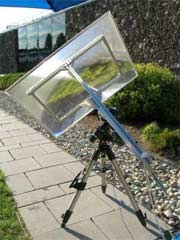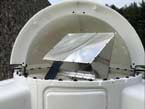IBM has announced a breakthrough in photovoltaics for solar farms that could significantly reduce the cost of harnessing the sun's power for electricity. 
By mimicking the antics of a child using a magnifying glass to burn a leaf or a camper to start a fire, IBM scientists are using a large lens to concentrate the sun's power, capturing about 230 watts, the most ever in such a small space: a centimeter square solar cell. That energy is then converted into 75 watts of usable electrical power, about five times the energy captured by typical cells used in solar farms, which rely on what is known as concentrator photovoltaics, or CPV. It is the most power available from such a small cell to date.
IBM's goal is to drive this towards commercialization by making it feasible to deploy these systems at a cost of less than two dollars per watt to install, and we believe that it should be possible to produce systems even cheaper than that. By using a much lower number of photovoltaic cells in a solar farm and concentrating more light onto each cell using larger lenses, IBM’s system enables a significant cost advantage in terms of a lesser number of total components and new manufacturing opportunities.
This is one of our exploratory research projects where we are looking to move IBM into adjacent spaces to our existing businesses. Solar cells use many of the same materials, processes, and underlying science that go into making computer chips and IBM has been a leading innovator in that space for decades. 
Concentrating solar power technologies are expected to offer the lowest-cost solar electricity for large-scale power generation but temperature control is a problem in optical concentrator cells due to the high sunlight concentration. The trick lies in IBM’s ability to cool the tiny solar cell. Concentrating the equivalent of 2000 suns on such a small area generates enough heat to melt stainless steel, something the researchers experienced first hand in their experiments. But by borrowing innovations from its own R&D in cooling computer chips, the team was able to cool the solar cell from greater than 1600 degrees Celsius to just 85 degrees Celsius.
Specifically, the team developed a system that achieved these results by coupling a commercial solar cell to an advanced IBM liquid metal thermal cooling system using methods developed for the microprocessor industry. They used a very thin layer of a liquid metal made of a gallium and indium compound that they applied between the chip and a cooling block. Such layers, called thermal interface layers, transfer the heat from the chip to the cooling block so that the chip temperature can be kept low. The IBM liquid metal solution offers the best thermal performance available today and the technology was successfully developed by IBM to cool high power computer chips earlier.

